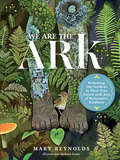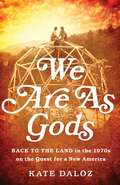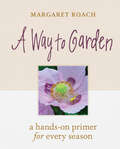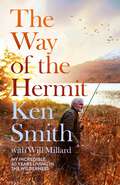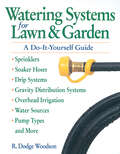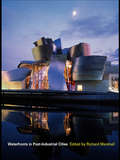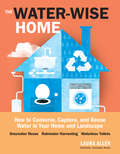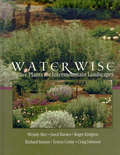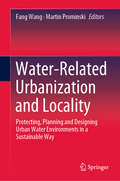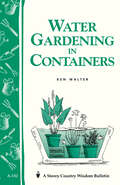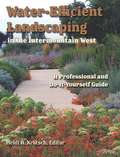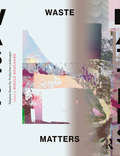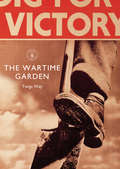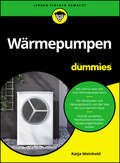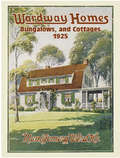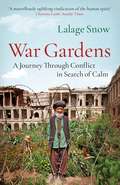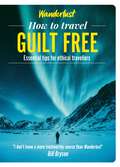- Table View
- List View
We Are the ARK: Returning Our Gardens to Their True Nature Through Acts of Restorative Kindness
by Mary Reynolds&“Reynolds gives us a much-needed reason for hope. The gardener, the conservationist, the city planner, and the nature lover will all be inspired for this wonderful book shows how thousands of even small wildlife friendly gardens can provide habitat for embattled wildlife around the world.&” —Jane Goodall, Phd, DBE, Founder of the Jane Goodall Institute & UN Messenger of Peace Individuals can&’t save the world alone. But if millions of us work together to save our own patch of earth—then we really have a shot. How do we do it? With Acts of Restorative Kindness (ARK). An ARK is a restored, native ecosystem. It&’s a thriving patch of native plants and creatures that have been allowed and supported to re-establish in the earth's intelligent, successional process of natural restoration. Over time, this becomes a pantry and a habitat for our pollinators and wild creatures who are in desperate need of support. These ARKs will become the seeding grounds for our planet&’s new story. They will be sanctuaries for our shared kin—the rooted and unrooted—and safe havens for the magic and abundance of the natural world. Most importantly, the ARK-building actions are within our control and laid out here in We Are the ARK. In these inspiring pages, discover how one person&’s actions can effect big change in this world. Even the tiniest postage stamp patch of land matters! Together we are building a patchwork quilt of life that will wrap its way around this planet.
We Are As Gods: Back to the Land in the 1970s on the Quest for a New America
by Kate DalozBetween 1970 and 1974 ten million Americans abandoned the city, and the commercialism, and all the inauthentic bourgeois comforts of the Eisenhower-era America of their parents. Instead, they went back to the land. It was the only time in modern history that urbanization has gone into reverse.Kate Daloz follows the dreams and ideals of a small group of back-to-the-landers to tell the story of a nationwide movement and moment. And she shows how the faltering, hopeful, but impractical impulses of that first generation sowed the seeds for the organic farming movement and the transformation of American agriculture and food tastes. In the Myrtle Hill commune and neighboring Entropy Acres, high-minded ideas of communal living and shared decision-making crash headlong into the realities of brutal Northern weather and the colossal inconvenience of having no plumbing or electricity. Nature, it turns out, is not always a generous or provident host-frosts are hard, snowfalls smother roads, and small wood fires do not heat imperfectly insulated geodesic domes.Group living turns out to be harder than expected too. Being free to do what you want and set your own rules leads to some unexpected limitations: once the group starts growing a little marijuana they can no longer call on the protection of the law, especially against a rogue member of a nearby community.For some of the group, the lifestyle is truly a saving grace; they credit it with their survival. For others, it is a prison sentence. We Are As Gods (the first line of the Whole Earth Catalog, the movement's bible) is a poignant rediscovery of a seminal moment in American culture, whose influence far outlasted the communities that took to the hills and woods in the late '60s and '70s and remains present in every farmer's market, every store selling Stonyfield products, or Keen shoes, or Patagonia sportswear.
We Are As Gods: Back to the Land in the 1970s on the Quest for a New America
by Kate DalozAt the dawn of the 1970s, waves of hopeful idealists abandoned the city and headed for the country, convinced that a better life awaited. They were full of dreams, mostly lacking in practical skills, and soon utterly out of money. But they knew paradise when they saw it. When Loraine, Craig, Pancake, Hershe, and a dozen of their friends came into possession of 116 acres in Vermont, they had big plans: to grow their own food, build their own shelter, and create an enlightened community. They had little idea that at the same moment, all over the country, a million other young people were making the same move -- back to the land.We Are As Gods follows the Myrtle Hill commune as its members enjoy a euphoric Free Love summer. Nearby, a fledgling organic farm sets to work with horses, and a couple -- the author's parents -- attempts to build a geodesic dome. Yet Myrtle Hill's summer ends in panic as they rush to build shelter while they struggle to reconcile their ideals with the somber realities of physical hardship and shifting priorities -- especially when one member goes dangerously rogue. Kate Daloz has written a meticulously researched testament to the dreams of a generation disillusioned by their parents' lifestyles, scarred by the Vietnam War, and yearning for rural peace. Shaping everything from our eating habits to the Internet, the 1970s Back-to-the-Land movement is one of the most influential yet least understood periods in recent history. We Are As Gods sheds light on one generation's determination to change their own lives and, in the process, to change the world.
A Way to Garden: A Hands-On Primer for Every Season
by Margaret RoachIn this lushly-photographed book, iconic garden voice Margaret Roach shows gardeners how to incorporate lessons from her glorious garden into their own home landscapes.
The Way of the Hermit: My incredible 40 years living in the wilderness
by Ken SmithCould you leave behind the bustle of modern life and spend a lifetime immersed in nature? In The Way of the Hermit, Ken Smith recounts a life he has chosen to spend alone with the wilderness.Seventy-four-year-old Ken Smith has spent the past four decades in the Scottish Highlands. He lives alone, with no electricity or running water. His home is a log cabin nestled near Loch Treig, known as 'the lonely loch', where he lives off the land: he fishes for his supper, chops his own wood, and even brews his own tipple. He is, in the truest sense of the word, a hermit.For the first time, Ken shares the story of his life. From his working-class origins in Derbyshire, to the formative years he spent travelling in the Yukon and finally how he came to be the Hermit of Loch Treig. Looking back through decades of diary entries, Ken reflects upon the reasons he turned his back on society, the vulnerability of old age and the awe and wonder of a life lived in nature. The Way of the Hermit is a humourous, transcendant and life-affirming memoir.
Watering Systems for Lawn & Garden: A Do-It-Yourself Guide
by R. Dodge WoodsonThis complete handbook is the perfect guide for anyone who wants to buy or install a small-scale irrigation system for the lawn, garden, or backyard. Covers everything from sprinklers and soaker hoses to overhead irrigation and gravity distribution systems.
Waterfronts in Post-Industrial Cities
by Richard MarshallMost books on waterfronts deal with a relatively narrow collection of cities and projects; one might describe them as the 'top ten' list of waterfront revitalisation projects. For instance, Boston and Baltimore are now the stuff of waterfront redevelopment legend. Waterfronts in Post-Industrial Cities is a second generation waterfront publication which reflects on recent and contemporary developments. Amsterdam, Boston, Genoa, Sydney and Vancouver are successful examples of cities that faced considerable challenges in their revitalisation efforts. Bilbao, Havana, Las Palmas de Gran Canaria and Shanghai are contemporary examples that represent the emerging contexts for waterfront revitalisation today.Four themes form the basis of this book and provide a structure for considering particular aspects of waterfront redevelopment - connection to the waterfront, remaking the city image on the waterfront, port and city relations and the new waterfronts in historic cities. Broad issues that might be applicable to a variety of situations are dealt with alongside specific city case studies.
Waterfronts in Post-Industrial Cities
by Richard MarshallMost books on waterfronts deal with a relatively narrow collection of cities and projects; one might describe them as the 'top ten' list of waterfront revitalisation projects. For instance, Boston and Baltimore are now the stuff of waterfront redevelopment legend. Waterfronts in Post-Industrial Cities is a second generation waterfront publication which reflects on recent and contemporary developments. Amsterdam, Boston, Genoa, Sydney and Vancouver are successful examples of cities that faced considerable challenges in their revitalisation efforts. Bilbao, Havana, Las Palmas de Gran Canaria and Shanghai are contemporary examples that represent the emerging contexts for waterfront revitalisation today.Four themes form the basis of this book and provide a structure for considering particular aspects of waterfront redevelopment - connection to the waterfront, remaking the city image on the waterfront, port and city relations and the new waterfronts in historic cities. Broad issues that might be applicable to a variety of situations are dealt with alongside specific city case studies.
The Water-Wise Home: How to Conserve, Capture, and Reuse Water in Your Home and Landscape
by Laura AllenLearn how to reduce water use in your home and build systems that reuse the water you do use.
Water Wise: Native Plants for Intermountain Landscapes
by Wendy MeeToday, native plants and water conservation are subjects of vital interest to cities, offices, homeowners, and agriculture alike, as all are affected by the growing shortage of water in the Intermountain region. This comprehensive volume provides specific information about shrubs, trees, grasses, forbs, and cacti that are native to most states in the Intermountain West, and that can be used in landscaping to conserve water, reflect and preserve the region's landscape character, and help protect its ecological integrity. The book is an invaluable guide for the professional landscaper, horticulturist, and others in the Intermountain nursery industry, as well as for the student, general reader, gardener, and homeowner. Water Wise is both convenient and comprehensive. The heart of the book presents hundreds of species, devoting a full page to each, with a description of appearance, habitat, landscape use, and other comments. Color photographs illustrate each plant described. A reader-friendly introduction provides important background on the ecology of the Intermountain West, along with full descriptions of native plant habitats and associations. An accessible resource of accurate native plant information for all readers, Water Wise will be indispensable to professional landscapers and amateurs alike.
Water-Related Urbanization and Locality: Protecting, Planning and Designing Urban Water Environments in a Sustainable Way
by Fang Wang Martin ProminskiThis book discusses the protection, planning, and design of sustainable urban water environments. Against the backdrop of environmental changes, it addresses issues of water resource protection and sustainable development in China and Germany at different stages of urbanization, as well as relevant strategies and lessons learned. It focuses on three topics: balance between water environment protection and utilization in the urbanization process; sustainable use of water resources in the urbanization process; and water-related planning and design strategies in urbanization and local cultural development processes. In the context of water resources, China and Germany can learn from each other’s experiences and can support one another in the fields of urbanization and locality. As such, the book brings together Chinese and Germans scientists from various disciplines, such as planning, geography, landscape, architecture, tourism, ecology, hydraulic engineering and history to provide a multicultural and multidisciplinary perspective on the topic and examine the challenges and opportunities as well as the planning and design strategies to achieve sustainable, water-related urban spaces. By combining theoretical and practical approaches, it appeals to academics and practitioners around the globe.
Water loss in plants (UEB uncontracted)
by RnibThis page shows an image of a small plant growing in the ground. There is a locator dot shown, which will be at the top left, when the image is the correct way up. The image is surrounded by a dashed line image border. The green leafy part of the plant is in the top half of the page and the root is in the bottom half of the page. The plans stem goes vertically up the middle of the page. It has three oval leaves on the left, one at the top forming the shoot, and four leaves on the right. Curved arrows indicate water loss as vapour from the leaves. A line going horizontally across the middle of the page represents the soil surface. Down from this the soil is shown in cross section so the roots can be found. As the root goes down the page it divides into smaller multiples of roots. Arrows show the root absorbing water from the soil.
Water loss in plants (large print)
by RnibThis page shows an image of a small plant growing in the ground. There is a locator dot shown, which will be at the top left, when the image is the correct way up. The image is surrounded by a dashed line image border. The green leafy part of the plant is in the top half of the page and the root is in the bottom half of the page. The plans stem goes vertically up the middle of the page. It has three oval leaves on the left, one at the top forming the shoot, and four leaves on the right. Curved arrows indicate water loss as vapour from the leaves. A line going horizontally across the middle of the page represents the soil surface. Down from this the soil is shown in cross section so the roots can be found. As the root goes down the page it divides into smaller multiples of roots. Arrows show the root absorbing water from the soil.
Water Gardening in Containers: Storey's Country Wisdom Bulletin A-182 (Storey Country Wisdom Bulletin)
by Ken WalterSince 1973, Storey's Country Wisdom Bulletins have offered practical, hands-on instructions designed to help readers master dozens of country living skills quickly and easily. There are now more than 170 titles in this series, and their remarkable popularity reflects the common desire of country and city dwellers alike to cultivate personal independence in everyday life.
Water Garden Construction: A Technical Guide for Designers (Workshops on Garden Design)
by Martin KelleyThe purpose of this book is to aid garden designers, their clients and contractors in their choice of water garden. By describing some of the commonly followed construction processes and explaining many of the practical design considerations, this book will help readers to avoid many problems and disappointments while their garden or landscape project is still in the design stage. The technical design of both formal and informal water gardens is described, and construction techniques that will be cost-effective yet durable are considered. The other fundamentals of water-level control and maintaining water clarity, both chemically and biologically, are also examined. Several case studies are included that show the design and construction process of individual water-garden projects, and explain the reasoning behind the designs, the negotiations involved and ultimate conclusions, together with schedules of works and budget costs. Salient points: * There is no other book on this subject aimed specifically at garden designers and landscape contractors; * Important case studies and costings featured; * Formal (small & largish gardens) and informal (ponds, lakes & waterfalls) water gardens are covered; * 'Before, during & after' photos of construction procedures included; * Detailed plans and line drawings amplify the text; * Detailed consideration of pond or lake lining materials covered; * Author is expert with own company making water gardens since 1982.
Water-Efficient Landscaping in the Intermountain West: A Professional and Do-It-Yourself Guide
by Heidi A. Kratsch Heidi KratschThis working manual provides complete information on the technical aspects of designing, building, and maintaining waterwise landscapes in the Mountain West. Written particularly for professionals, including landscape designers, architects, contractors, and maintenance and irrigation specialists, it has an attractive, well-illustrated, user-friendly format that will make it useful as well to DIY homeowners and to educators, plant retailers, extension agents, and many others. The manual is organized according to landscape principles that are adapted to the climate of the intermountain region. Beginning with planning and design, the topical principles proceed through soil preparation, appropriate plant selection, practicalities of turfgrass, use of mulch, and irrigation planning, winding up with landscape maintenance. Designed for onsite, handy use, the book is illustrated with color images of landscapes, plants, and materials. Tables, charts, diagrams, landscape plans, plant lists, checklists, and other graphic resources are scattered throughout the manual, which is written in an accessible but information-rich style. Water-Efficient Landscaping in the Intermountain West answers, more comprehensively than any other single book, the need for professional information that addresses both growing awareness of the necessity for water conservation and the desire for beautiful, healthy yards and properties.
Waste Matters: Adaptive Reuse for Productive Landscapes
by Nikole BouchardFor thousands of years humans have experimented with various methods of waste disposal—from burning and burying to simply packing up and moving in search of an unscathed environment. Habits of disposal are deeply ingrained in our daily lives, so casual and continual that we rarely ever stop to ponder the big-picture effects on social, spatial and ecological orders. Rethinking the ways in which we produce, collect, discard and reuse our waste, whether it’s materials, spaces or places, is essential to ensure a more feasible future. Waste Matters: Adaptive Reuse for Productive Landscapes presents a series of historical and contemporary design ideas that reimagine a range of repurposed materials at diverse scales and in various contexts by exploring methods of hacking, disassembly, reassembly, recycling, adaptive reuse and preservation of the built environment. Waste Matters will inspire designers to sample and rearrange bits of artifacts from the past and present to produce culturally relevant and ecologically sensitive materials, objects, architecture and environments.
Waste Matters: Adaptive Reuse for Productive Landscapes
by Nikole BouchardFor thousands of years humans have experimented with various methods of waste disposal—from burning and burying to simply packing up and moving in search of an unscathed environment. Habits of disposal are deeply ingrained in our daily lives, so casual and continual that we rarely ever stop to ponder the big-picture effects on social, spatial and ecological orders. Rethinking the ways in which we produce, collect, discard and reuse our waste, whether it’s materials, spaces or places, is essential to ensure a more feasible future. Waste Matters: Adaptive Reuse for Productive Landscapes presents a series of historical and contemporary design ideas that reimagine a range of repurposed materials at diverse scales and in various contexts by exploring methods of hacking, disassembly, reassembly, recycling, adaptive reuse and preservation of the built environment. Waste Matters will inspire designers to sample and rearrange bits of artifacts from the past and present to produce culturally relevant and ecologically sensitive materials, objects, architecture and environments.
Washi Tape Crafts: 110 Ways to Decorate Just About Anything
by Amy AndersonIt&’s the definitive washi tape craft book for adults. Washi tape—the Japanese decorative paper tape that&’s easy to tear, peel, stick and re-stick—is transformative, fun, and remarkably easy to use. It&’s also never been hotter. Packed full of amazing projects and ideas, it&’s the book and tape kit that shows all the ways to be creative with washi tape. The book includes techniques: precision tearing, wrapping, and weaving. How to make bows, rosettes, and other shapes. How to seal and weatherproof designs to make them permanent. And 110 projects, with color photographs and step-by-step instructions, from custom photo frames to one-of-a-kind gifts. The possibilities are endless.
The Wartime Garden: Victory (Shire Library)
by Sarah Rutherford Twigs WayThis War is a Food War…' In 1941 Lord Woolton, Minister for Food, was determined that the Garden Front would save England: 'Dig for Victory' was the slogan, digging for dinner the reality. With food imports dwindling the number of allotments grew, millions opted to 'Spend an Hour with a Hoe' instead of an hour in a queue, and the upper classes turned lawns, tennis courts and stately gardens over to agriculture. The national diet was transformed, with swedes grown in the place of oranges and hapless children sucking on carrot lollies; evacuees grew their own meals and bomb sites sprouted allotments. Vegetables ruled the airwaves with Mr Middleton's 'In Your Garden' whilst Home Guard potatoes became the favourites of the Kitchen Front. This is a fully illustrated look at the time when gardening saved Britain.
Wärmepumpen für Dummies (Für Dummies)
by Katja WeinholdSie möchten verstehen, wie Wärmepumpen funktionieren, wie Sie sie in Ihr (bestehendes) Heiz- und Kühlsystem optimal integrieren, welche Förderung Sie erhalten und welche Kosten im Falle eines Einbaus auf Sie zukämen? Dann ist dieses Buch wie für Sie gemacht. Es erklärt die Technik leicht verständlich, macht mögliche Kosten transparent und unterstützt Sie so bei der Entscheidungsfindung. Darüber hinaus zeigt es Ihnen ganz konkret, welche Schritte Sie unternehmen müssen, wenn Sie sich für einen Einbau entscheiden.
Wardway Homes, Bungalows, and Cottages, 1925 (Dover Architecture)
by Montgomery Ward Co.Meticulous reproduction of a rare catalog includes floor plans as well as exterior and interior views of 80 American homes, among them a handsome, three-story frame residence with six bedrooms and a cozy, three-room cottage measuring 18 feet by 22 feet. 94 black-and-white illustrations depict handsome stairways, French doors, and other amenities.
War Gardens: A Journey Through Conflict in Search of Calm
by Lalage Snow'A remarkable book . . . It's a powerful testament to the healing balm of gardening and the resilience of the human spirit in the direst of circumstances.' Financial Times'Not a happy book and yet it's magically heartening. It makes a gardener question his or her values.' The Times'This extraordinary book...warm and engaging...like a photograph magicked to life.' Spectator'Snow has spent ten years as a photographer and filmmaker covering unrest . . . Throughout that time she has sought comfort in green oases and come to understand "how vital gardens are 'against a horrid wilderness' of war". . . There can be few counter-narratives as enchanting and sad as those Snow recounts in War Gardens.' Times Literary Supplement'For all these victims of war, their gardens are places in which to breathe, providing moments of calm, hope and optimism in a fragile life of horror and uncertainty. For many, it helps them to grieve. Books seldom bring a lump to my throat, but this one did.' Spectator'What makes War Gardens the most illuminating garden book to be published this year, is the realisation that people's gardens are the antidotes to the horrors of their surroundings.' Country LifeA journey through the most unlikely of gardens: the oases of peace people create in the midst of warIn this millennium, we have become war weary. From Afghanistan to Iraq, from Ukraine to South Sudan and Syria, from Kashmir to the West Bank, conflict is as contagious and poisonous as Japanese knotweed. Living through it are people just like us with ordinary jobs, ordinary pressures and ordinary lives. Against a new landscape of horror and violence it is up to them to maintain a modicum of normality and colour. For some, gardening is the way to achieve this.Working in the world's most dangerous war zones, freelance war correspondent and photographer Lally Snow has often chanced across a very moving sight, a testimony to the triumph of the human spirit in adversity, a celebration of hope and beauty: a war garden. In Kabul, the royal gardens are tended by a centenarian gardener, though the king is long gone; in Camp Bastion, bored soldiers improvise tiny gardens to give themselves a moment's peace; on both sides of the dividing line in Jerusalem families tend groves of olives and raise beautiful plants from the unforgiving, disputed landscape; in Ukraine, families tend their gardens in the middle of a surreal, frozen war.War Gardens is a surprising, tragic and beautiful journey through the darkest places of the modern world, revealing the ways people make time and space for themselves and for nature even in the middle of destruction. Illustrated with Lally Snow's own award-winning photography, this is a book to treasure.
Wanstead House: East London's Lost Palace
by Hannah ArmstrongIn c.1713, Sir Richard Child, heir to a mercantile fortune, commissioned Colen Campbell, to build Wanstead House, ‘one of the noblest houses, not only in England, but in Europe’. Campbell’s innovative classical façade was widely influential and sowed the seeds for English Palladianism. Its opulent interior by William Kent was equal to Kensington Palace and its extensive gardens were attributed to leading landscape designers George London and Humphry Repton. Wanstead’s glory days came to an end in 1822, when a major sale of its contents was arranged to pay off financial debts. Two years later the house was demolished, its building fabric dispersed far and wide. A large crater on an east London golf course is all that remains of this once ‘princely mansion’. Based on scholarly research, Wanstead House: East London’s Lost Palace provides the first illustrated history of the lost Georgian estate, charting the meteoric rise and fall of the Child dynasty. By restoring Wanstead’s reputation amongst the leading houses of the era, this book demonstrates that those lost in actuality, should by no means be lost to history.
Wanderlust - How to Travel Guilt Free: Holiday tips for ethical travellers
by Hazel Plush WanderlustWe have never been more conscious of our impact on the environment. At work, home and in nature, we strive to find balance with our surroundings – but how can you indulge your love of exploring the world without damaging it in the process?How to Travel Guilt Free is the Wanderlust magazine guide to eco-friendly travel. Whether you're enjoying a staycation or heading off on a round-the-world trip, Wanderlust's expert travel writers have 100 essential tips to make your adventures green, every step of the way. From where to go, how to get there, what to take and what to avoid, How to Travel Guilt Free will change the way you approach your every expedition. Helping you to tune in with the delicate balance of incredible destinations around the world, embrace mindful voyages and ultimately find a kind, honest and harmonious new travel philosophy.
